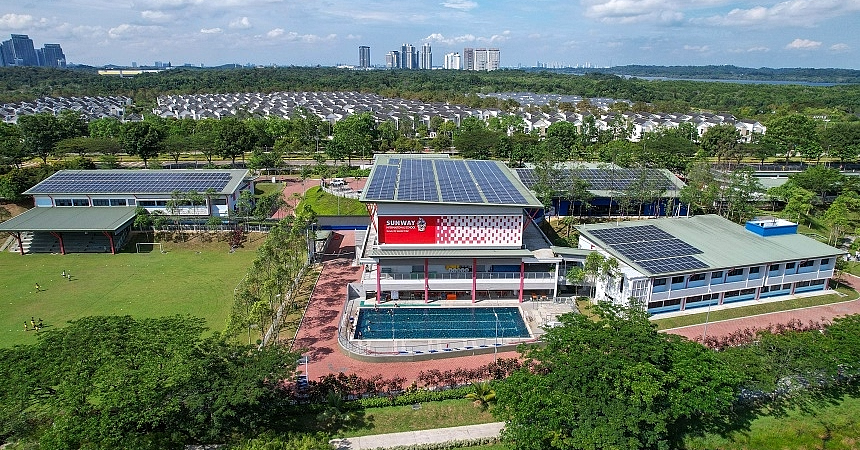
When South Korean national Maryanna Kim was offered a job in Malaysia, one of her key motivations for saying yes was the opportunity to enrol her children in the international schools in the country.
Her two daughters, aged 12 and 15, had been attending private elementary school in Seoul.
Ms Kim herself had studied at an international school in Kuala Lumpur in the 1990s for five years, as her father was posted there for work.
Her positive personal experience made sending her children to an international school in Malaysia a top priority.
“I wanted to raise my daughters as global citizens, exposed to diverse ethnicities and religions – something that Korean international schools, with over 95 per cent local enrolment, don’t offer,” said the 45-year-old, who works as the chief communications officer at Capital A, formerly known as AirAsia Group.
It does not hurt either that the fees for international schools in Malaysia are around 30 per cent lower than those in Seoul, said Ms Kim, who has been living with her family in Kuala Lumpur since 2019.
Her younger daughter attends Alice Smith School in the capital city, and the older one goes to Epsom College in Negeri Sembilan, which has boarding facilities.
Malaysia’s international schools are welcoming more students like Ms Kim’s children, with the sector gaining popularity among foreign families who see it as an option for quality education at a more pocket-friendly price compared with their home countries.
In the five years to July 2024, enrolment numbers at Malaysia’s international schools have increased by 11 per cent to a total of 111,185 students, according to the British-based ISC Research, which collects data on the global international school industry.
It refers to international schools as privately operated institutions catering to students from the pre-school to pre-university levels, which offer learning curricula wholly or partly in English to those aged between three and 18.
To meet growing demand, the number of international schools in Malaysia has also risen in tandem, increasing by 11 per cent over the same five-year period to 348, with some offering boarding facilities as well.
“Demand for international schools is growing in Malaysia. Penang and Kuala Lumpur are becoming increasingly attractive destinations for expatriates, with new international schools being established as a result,” ISC Research noted.
There is also an influx of students from other Asian countries, particularly China, South Korea, Japan and India.
“This demand is supported by Malaysia’s growing economy, on-going foreign investments and the Malaysian government’s efforts to position the country as an education hub,” ISC Research stated.
The Association of International Malaysian Schools (AIMS), which facilitates communication between international schools and the relevant government authorities, noted anecdotally that the increasing number of students – especially from China, South Korea and Japan – was due to lower fees compared with places such as Singapore or China.
“There has been a strong desire after the pandemic for international school education in Malaysia, with growth particularly driven by students from China, Korea and Japan,” said AIMS vice-chairman Sam Gipson.
He added that competition for international school placements in other countries has also made it more difficult for foreign students to enrol elsewhere.
The availability of international schools that also have boarding facilities, such as British schools Marlborough College in Johor and Epsom College in Negeri Sembilan, is also a factor that many parents take into consideration.
Gipson told The Straits Times that enrolment in Singapore’s international schools is highly competitive.
But with a limited supply of such educational institutions as well as long waiting lists for schools in the city-state, many families are open to what Malaysia has to offer.
“Malaysia has a high concentration of quality schools with global affiliations and accreditations, excellent teachers and great facilities, often at a lower fee point,” he said.
ISC Research said more international schools are also establishing themselves beyond the Klang Valley area and Kuala Lumpur, in places such as Ipoh, Penang and Johor Bahru.
Penang, in particular, is seeing increased enrolment from European families due to the presence of large European companies in the northern state, it added.
The state is an established semiconductor hub known as the Silicon Valley of the East.
Sunway International Schools, which has two campuses in Selangor and Johor, said it has observed an increase in interest and enrolment from international students, particularly those from China.
This was due to “word of mouth and positive feedback from (other) Chinese parents”, its executive director Cheng Mien Wee told ST.
The schools offer internationally recognised school curricula such as the Canadian curriculum, the Cambridge curriculum and the International Baccalaureate programme.
In December 2023, Malaysia relaxed its travel policy, allowing Chinese nationals to enter for social visits without requiring a visa, which has also contributed to the overall interest, said Dr Cheng.
Gipson said the Covid-19 pandemic had led to a number of international schools in China shuttering, which also affected the quality of education and services that schools there could provide.
As a result, Chinese nationals looking to put their children in international schools have had to look elsewhere, such as Malaysia.
One Chinese national, who wanted to be known only as Ms Feng, said the primary reason for the family’s move to Malaysia was to enrol her six-year-old son in an international school.
“In China, there’s overwhelming demand for international schools, which has driven fees to almost double compared with Malaysia,” said the 47-year-old housewife.
For example, high school fees could cost RM150,000 a year in China, versus an estimated RM50,000 to RM70,000 per year in Malaysia, she added.
“It is a big difference,” she said.
Malaysia also offers a wider range of international schools to choose from compared with back home, said Feng.
But it is not just expatriates who are adding to the growing demand for international schools. Local students, too, are adding to the numbers.
The number of Malaysian students enrolled in international schools in the country rose 34 per cent from 2019 to 2024, Education Minister Fadhlina Sidek said in July.
As at May 31, local students made up around 67 per cent of the international school enrolment, while foreign students accounted for about 33 per cent, according to the country’s Ministry of Education.
Some Malaysian parents say they switched to international schools because the medium of instruction is English, and they want to ensure their children have access to world-class education.
Housewife S.M. Lau, 56, said she sent her two children to an international school as she believes there is more consistency in the syllabus taught.
Lau also felt her children would benefit from having English as the medium of instruction at school, as this would make it easier for them to study overseas in the future.
ADVERTISEMENT
ADVERTISEMENT








































